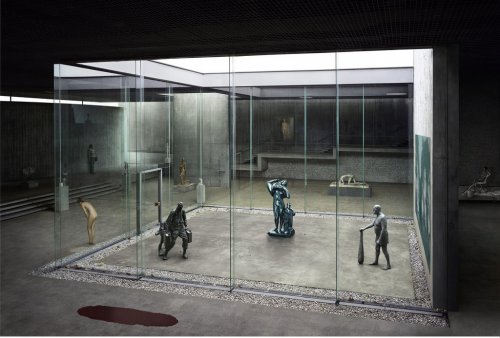 |
| Andreas Gursky, Lager, 2013 |
| Andreas Gursky, Beelitz, 2007 |
I want to make the claim that Gursky is the Gerhard Richter
of photography. That is to say, Gursky takes the medium to new levels of
experimentation, and with it his viewer is led to new levels of uncertainty,
new revelations about seeing, about expectations, about art. Even though the two
work in different media, Richter is a painter even when he photographs, Gursky
is a photographer even when the images appear to be a long way from
photography, both create enigmatic images filled with moebius-like
conceptual layers inside perfectly constructed, controlled grids, planes and
structural forms.
 |
| Andreas Gursky, Lehmbruck, I 2014 |
An image such as Lager,
2013 appears at first glance to be perfectly formed, logically structured. In a
characteristic Gursky gesture, from afar the photograph looks very
straightforward. A gridded structure, receding into the distance, presumably
for storing art works. Time spent with the image reveals its disturbance. The
edge of recognizeable Gursky photographs can be seen attached to the structure. Philosophical text and
the departure board at Frankfurt airport become equated, given the same
conceptual and visual status, at the same distance from the camera even though
the one is further back than the other. Ultimately, it is not a question of placement within the image anyway; philosophy and airplane departures are the same thing because they are both the substance of Gursky photographs. We are drawn to read the text, but
because the edges are missing, no sense can be made of it. And then we see that
the gridded structure does not recede at all, all pieces on the same plane, or
perhaps there is a mirror placed half way back? Rather than effecting a mise-en-abîme, the background is pushed
forward, onto the same plane as the foreground, emphasizing the artificiality
both of the representation, and of the storage space for images that do not
exist, images of which only an edge is real. Yet again, Gursky creates a
reality that is more credible as abstraction, an illusion we yearn to make sense
of.
 |
| Andreas Gursky, Katar, 2012 |
The two masterpieces of the Bermondsey exhibition are the
twin images, entitled Lehmbruck I
(2013) and Lehmbruck II (2014). Gursky
photographs the Duisburg museum made of concrete and glass, from above and at
an angle, a place that could not be possible, but yet, must be, because it is in the photograph. The impossibility
of the angle from which he photographs the glass enclosure of a temporary
exhibition (the works in the enclosure are well know and belong to other
museums) pushes Gursky’s viewer away, giving her no access to the relationship
between objects, between the internal spaces within the museum, between her and
the photograph. Where the foreshortened, or maybe mirrored, perspective in Lager, creates a barrier to the viewer’s
involvement, so the obscure perspective from which Gursky sees the Lehmbruck
museum draws us into a process of trying in vain to determine from where we are
seeing. As viewers we become lost in our
questions about the construction of the image, ultimately never getting beyond
the puzzle of what we are looking at, whether it is an illusion, or if it is
so artificially manipulated that we are being deceived. Even when we recognize
the building of the Duisburg Museum, we still doubt the reality of what we are
looking at.
 |
| Andreas Gursky, Untitled XVII, 2014 |
Of course, these formal games and manipulations are making
reference to the institutions which house art, to popular culture, in the same
way that Gursky has been preoccupied with the stock exchange, formula one
racing and libraries in the past. However, what remains innovative about
these enormous photographs is not what they depict, but how they depict it. As
I suggested in my blog on the early landscapes at Sprüth Magers, Gursky pushes
photography into a world where it becomes other than photography: his prints
are huge, inkjet, digitally manufactured, not just manipulated, created as if
in a dream. Gursky takes photography
somewhere that is no longer recognizeable in images that present places that no
longer exist, or perhaps they never did.
 |
| Andreas Gursky, Untitled XV, 2008 |
The White Cube exhibition demonstrates that Gursky is an artist
at the height of his career, doing things with photography that are otherwise
unimaginable. He pushes photography beyond its limits into unchartered territories,
territories that exist nowhere but on the illusory surface of Gursky’s
photographs. I can’t think of another photographer who is challenging the
ontology of his medium in the same way. Lastly, the gallery itself is the
perfect environment for Gursky’s large-scale photographs. Superbly curated,
apparently by the artist himself, these old warehouse spaces honour works that
are complex, ambiguous and unsettling on every level.
All Images Courtesy the artist
No comments:
Post a Comment